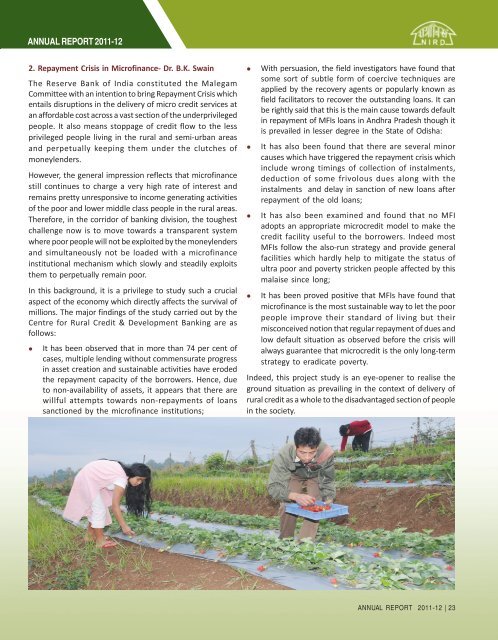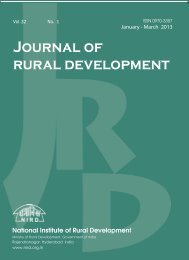Annual Report 2011-2012 - National Institute of Rural Development
Annual Report 2011-2012 - National Institute of Rural Development
Annual Report 2011-2012 - National Institute of Rural Development
- No tags were found...
You also want an ePaper? Increase the reach of your titles
YUMPU automatically turns print PDFs into web optimized ePapers that Google loves.
ANNUAL REPORT <strong>2011</strong>-122. Repayment Crisis in Micr<strong>of</strong>inance- Dr. B.K. SwainThe Reserve Bank <strong>of</strong> India constituted the MalegamCommittee with an intention to bring Repayment Crisis whichentails disruptions in the delivery <strong>of</strong> micro credit services atan affordable cost across a vast section <strong>of</strong> the underprivilegedpeople. It also means stoppage <strong>of</strong> credit flow to the lessprivileged people living in the rural and semi-urban areasand perpetually keeping them under the clutches <strong>of</strong>moneylenders.However, the general impression reflects that micr<strong>of</strong>inancestill continues to charge a very high rate <strong>of</strong> interest andremains pretty unresponsive to income generating activities<strong>of</strong> the poor and lower middle class people in the rural areas.Therefore, in the corridor <strong>of</strong> banking division, the toughestchallenge now is to move towards a transparent systemwhere poor people will not be exploited by the moneylendersand simultaneously not be loaded with a micr<strong>of</strong>inanceinstitutional mechanism which slowly and steadily exploitsthem to perpetually remain poor.In this background, it is a privilege to study such a crucialaspect <strong>of</strong> the economy which directly affects the survival <strong>of</strong>millions. The major findings <strong>of</strong> the study carried out by theCentre for <strong>Rural</strong> Credit & <strong>Development</strong> Banking are asfollows:It has been observed that in more than 74 per cent <strong>of</strong>cases, multiple lending without commensurate progressin asset creation and sustainable activities have erodedthe repayment capacity <strong>of</strong> the borrowers. Hence, dueto non-availability <strong>of</strong> assets, it appears that there arewillful attempts towards non-repayments <strong>of</strong> loanssanctioned by the micr<strong>of</strong>inance institutions;With persuasion, the field investigators have found thatsome sort <strong>of</strong> subtle form <strong>of</strong> coercive techniques areapplied by the recovery agents or popularly known asfield facilitators to recover the outstanding loans. It canbe rightly said that this is the main cause towards defaultin repayment <strong>of</strong> MFIs loans in Andhra Pradesh though itis prevailed in lesser degree in the State <strong>of</strong> Odisha:It has also been found that there are several minorcauses which have triggered the repayment crisis whichinclude wrong timings <strong>of</strong> collection <strong>of</strong> instalments,deduction <strong>of</strong> some frivolous dues along with theinstalments and delay in sanction <strong>of</strong> new loans afterrepayment <strong>of</strong> the old loans;It has also been examined and found that no MFIadopts an appropriate microcredit model to make thecredit facility useful to the borrowers. Indeed mostMFIs follow the also-run strategy and provide generalfacilities which hardly help to mitigate the status <strong>of</strong>ultra poor and poverty stricken people affected by thismalaise since long;It has been proved positive that MFIs have found thatmicr<strong>of</strong>inance is the most sustainable way to let the poorpeople improve their standard <strong>of</strong> living but theirmisconceived notion that regular repayment <strong>of</strong> dues andlow default situation as observed before the crisis willalways guarantee that microcredit is the only long-termstrategy to eradicate poverty.Indeed, this project study is an eye-opener to realise theground situation as prevailing in the context <strong>of</strong> delivery <strong>of</strong>rural credit as a whole to the disadvantaged section <strong>of</strong> peoplein the society.ANNUAL REPORT <strong>2011</strong>-12 | 23
















